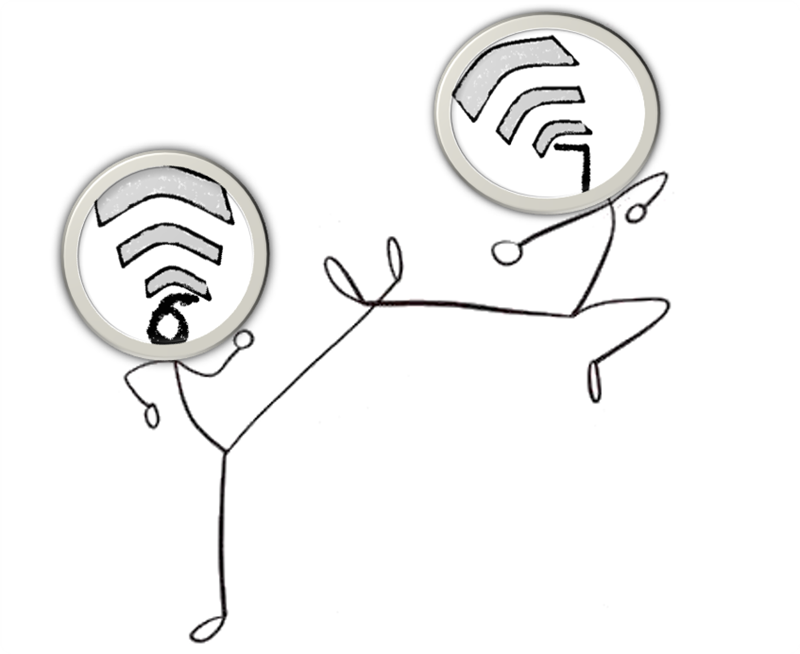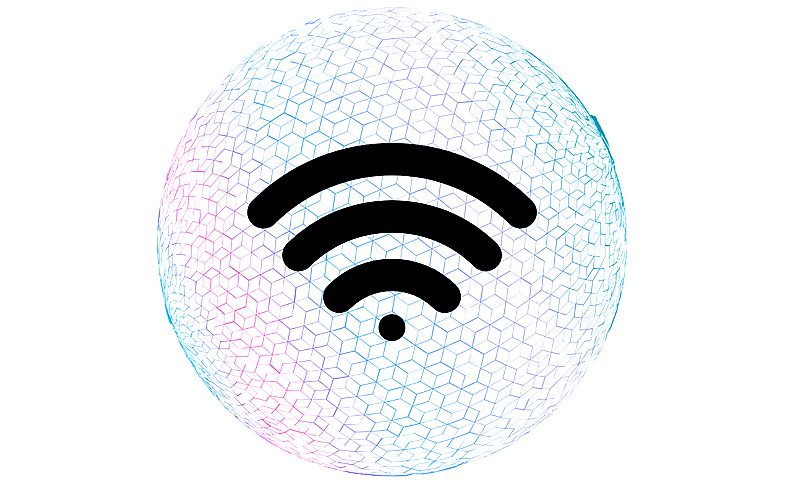Blog
WiFi 6 vs WiFi 7 vs WiFi 6E: What is the difference?
Initial Published: September 20, 2024
Since its invention in 1997, WiFi has been constantly updated and iterated. In recent years, WiFi 6, WiFi 6E, and WiFi 7 have been launched one after another. When comparing WiFi 6 vs WiFi 7, it’s essential to understand the key differences. What upgrades have they made compared to the previous generation of WiFi technology?
Below, I will take you to learn more about the three different versions of WiFi technology; let’s start exploring together!
Table of contents
What is WiFi 6?
Released in 2019, WiFi 6, also known as 802.11ax , supports high-speed, low-latency connections with a theoretical maximum speed of 9.6 Gigabits per second (roughly 2.6 times WiFi 5). WiFi 6 maintains backward compatibility with older devices while increasing capacity and security, improving data rates, reducing network congestion, and extending battery life for compatible devices.
WiFi 6 simultaneously supports uplink and downlink MU-MIMO, uploading and downloading data between mobile devices. It handles more devices without compromising speed and performance, significantly improving the utilization of the wireless bandwidth network and providing a faster data transmission rate for multiple users. Furthermore, the transmission channels of multiple users are independent, and there is no interference between them.
What is WiFi 6E?
In 2020, WiFi 6E was released, opening new radio waves for WiFi signals in the 6 GHz band. The additional band quadruples the radio waves available to APs, routers, and smart devices. This will give users access to high bandwidth and low latency for new applications such as AR/VR, cloud gaming, 4K/8K streaming, and other activities.
What is WiFi 7?
802.11be, the latest WiFi technology, will transmit data on three frequency bands – 2.4 GHz, 5 GHz, and 6 GHz – which means it will have an additional band. It will solve the problems of latency, congestion, and other issues prevalent in the previous generations of WiFi technology. At the same time, the data transfer rate will be much higher and will also support more connections.
Advanced Features of WiFi 7
- Data transfer rate: WiFi 7 will have a peak speed of up to 46Gbps, about 4.8 times faster than WiFi 6.
- Multi-Link Operation (MLO): WiFi 7 will operate in the 2.4GHz, 5GHz, and 6GHz bands. Before WiFi 7, simultaneous transmissions were limited to a single band. mLO allows devices to be permitted on multiple bands simultaneously, solving the problem of congestion and interference on a single band and dramatically reducing data latency.
- Channel bandwidth: WiFi 7’s channel bandwidth is up to 320MHz, twice as wide as WiFi 6. The wider bandwidth significantly improves WiFi 7’s network performance and data transmission capacity.
- Data density: WiFi 7 improves speed and bandwidth and uses 4K-QAM (4096 quadrature amplitude modulation) to improve data transmission rates versus WiFi 6/6E by up to 20% because a higher QAM can pack signals more densely.
- Upgraded Security: WiFi 7 supports WPA3 (WiFi Protected Access Protocol version 3) as the default security standard, providing more robust encryption algorithms and authentication mechanisms. In addition, WiFi 7 introduces new technologies, such as Simultaneous Authentication of Equals (SAE), to enhance network security and privacy protection.
- Multi-Resource Unit (RU): similar to MLO, this feature is designed to solve the congestion problem. In WiFi 6, each user can only send or receive frames on a specific RU (Resource Unit) assigned to it, greatly limiting the flexibility of spectrum resource scheduling.WiFi 7 breaks this limitation by allowing multiple RUs to be assigned to a single user through the Multi-RU technique. This allocation improves the efficiency of spectrum resource utilization and allows the network to respond more flexibly to the needs of different devices and applications.

WiFi 6 vs WiFi 6E vs WiFi 7, what are their differences?
The main features of WiFi 6 and WiFi 6E are the same, and WiFi 6E may have upgraded certain features. Compared with WiFi 6, the most significant change in WiFi 6E is adding a 6GHz band. WiFi 7 is a vast change from WiFi 6E. The throughput and bandwidth increase exponentially. The following table shows the specific differences between WiFi 6, WiFi 6E, and WiFi 7:
| WiFi 6 | WiFi 6E | WiFi 7 | |
| IEEE standard | 802.11ax | 802.11ax | 802.11be |
| Year of generation | 2019 | 2020 | 2024 |
| Supported frequency bands | 2.4GHz、5HGz | 2.4GHz, 5HGz, and 6GHz | 2.4GHz, 5HGz, and 6GHz |
| Coverage | WiFi 6>WiFi 6E | ABOUT THE SAME WITH WiFi 7 | ABOUT THE SAME AS WiFi 6E |
| Channel width | 20/40/80/ 80+80/160 MHz | 20/40/80/ 80+80/160 MHz | 20/40/80/ 160/320 MHz |
| Upgrade and innovate | Target Wake Time (TWT), OFDMA technology | 6 GHz band | multi-link operation (MLO), Multi-Resource Unit (RU), Enhanced Multilink Single Radio (eMLSR) |
| Spatial streams | Up to 8 | Up to 8 | Up to 16 |
| Delay | 20-40 ms | 20-40 ms | 5 milliseconds or less |
| Data transfer rate (throughput) | Up to 9.6Gbps | Up to 9.6Gbps | Up to 46Gbps |
| Modulation | Up to 1024-QAM | Up to 1024-QAM | Up to 4096-QAM |
| RU | RU | RU | Multi-RU |
| MIMO | 8×8 UL/DL MU-MIMO | 8×8 UL/DL MU-MIMO | 16×16 UL/DL MU-MIMO |
| compatibility | Backward Compatible | Not Backward Compatible | Backward Compatible |
| Security | WPA3 | WPA3 | WPA3 (Enhanced) |
| Application | places with high traffic such as schools, office buildings, shopping malls, etc | Extended to the 6 GHz band, suitable for environments with high user density and high interference. For low latency and high bandwidth requirements, WiFi 6E can provide better support, such as AR/VR. | Applications that require extremely low latency and high reliability, such as cloud gaming, real-time virtual reality. Smart manufacturing and IoT: e.g. smart cities, large-scale Internet of Things (IoT). High bandwidth requirements, such as 8K UHD media transmission. |
WiFi 6 vs WiFi 6E: which one should you choose?

From the compatibility aspect, WiFi 6 is backward compatible with devices of earlier WiFi standards, while WiFi 6E is not. If you choose WiFi 6E, you will have to buy additional corresponding devices, which will be a big expense.
In terms of performance, WiFi 6E offers faster speeds, lower latency, less congestion, and more excellent resistance to interference, so it’s better to choose WiFi 6E.
Considering the technology upgrade: The most significant technical advantage of WiFi 6E is the introduction of the 6GHz band, a brand new frequency band. Its significance lies in the fact that it is an untrodden path and not crowded. Moreover, the WiFi 7 technology supports 6GHz, so choosing WiFi 6E can help you keep pace with future trends.
The above suggestion is not perfect. There are also price and installation costs, and you need to consider other factors when choosing exactly which one to go with. I can’t give you a definitive answer, but you can consider my suggestions above.
WiFi 6 vs WiFi 7: should you upgrade?

If you want to keep up with future trends and improve network performance and speed, you can wait for WiFi 7 to enter the market. But buying the appropriate supporting devices will cost you high. Because even though it is backward compatible, you still need to buy the latest compatible devices to get the best performance of WiFi 7.
In contrast, WiFi 6 is already widely used. If WiFi 6 is already good enough for your personal needs, why wait a long time and spend money to upgrade?
All in all, it is indisputable that in the future, WiFi 7 may be replaced by WiFi 8 or WiFi 9, and WiFi 6 may become an older model. But for now, we should combine our needs and budget, choose the most suitable one and then decide whether to update or not.
FAQ
Q: Will WiFi 7 improve the coverage?
A: No. The frequency band affects coverage. Generally, high frequencies attenuate more when traveling through air or obstacles, and the coverage is small. The opposite is true for low frequencies. However, WiFi 6E and WiFi 7 are in the same frequency bands: 2.4GHz, 5HGz, and 6GHz, so WiFi 7 will not improve coverage.
Q: Is WiFi 7 better than WiFi 6?
A: yes. WiFi 7 is better than WiFi 6 because it has been optimized in many ways, such as providing additional frequency bands, 4.8 times faster speeds, 2 times the channel bandwidth, and adopting more advanced technologies.
Q: Which is better for gaming, WiFi 6 or WiFi 6E?
A: It’s hard to say. WiFi 6 is good enough for a decent gaming experience, but if you need to switch to AR/VR-based gaming, WiFi 6E will perform better, as it is suitable for data-intensive applications such as AR/VR.
Q: How fast is WiFi 7?
A: Theoretical speeds are as high as 36Gbps, and in particular, Internet throughput for a single client device is expected to be close to -5Gbps, which is more than twice the speed of the WiFi6- standard. However, whether these predictions will be realized in practice is still an open question.
Q: What are the main technical improvements of WiFi 6 compared to WiFi 5?
A: There are two main technical improvements. First, OFDMA (Orthogonal Frequency Division Multiple Access) technology has been introduced, which allows multiple devices to transmit data on the same channel at the same time, thus optimizing channel utilization and reducing latency.
Second, WiFi6 also adds the TWT (Target Wake Time) feature, which saves battery life by scheduling device wake-up times while supporting higher speeds and enhanced multi-device processing.
Conclusion
We have discussed these WiFis specifically above and compared them.
You can make your choice based on these differences and your personal needs. WiFi 7 is a new generation of WiFi that outperforms previous generations and, more importantly, represents the future, but this new technology will be slow to apply. The current WiFi 6 devices will be sufficient for most average users.
Read more
- Internet vs WiFi: What Are the Key Differences
- UTP vs. STP vs. FTP vs. S/FTP Cable, What is The Difference
- How to Accelerate Fiber Network Deployment?
- 100G Transceiver, DAC, or AOC: Which one to Choose?







